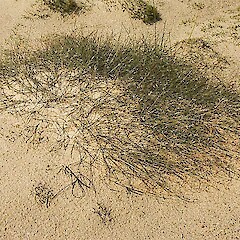Lachnagrostis ammobia
Synonyms
None
Family
Poaceae
Flora category
Vascular – Native
Endemic taxon
Yes
Endemic genus
No
Endemic family
No
Structural class
Grasses
Chromosome number
2n = 98
Current conservation status
The conservation status of all known New Zealand vascular plant taxa at the rank of species and below were reassessed in 2017 using the New Zealand Threat Classification System (NZTCS) – more information about this can be found on the NZTCS website. This report includes a statistical summary and brief notes on changes since 2012 and replaces all previous NZTCS lists for vascular plants.
Please note, threat classifications are often suggested by authors when publications fall between NZTCS assessment periods – an interim threat classification status has not been assessed by the NZTCS panel.
- Conservation status of New Zealand indigenous vascular plants, 2017 . 2018. Peter J. de Lange, Jeremy R. Rolfe, John W. Barkla, Shannel P. Courtney, Paul D. Champion, Leon R. Perrie, Sarah M. Beadel, Kerry A. Ford, Ilse Breitwieser, Ines Schönberger, Rowan Hindmarsh-Walls, Peter B. Heenan and Kate Ladley. Department of Conservation. Source: NZTCS and licensed by DOC for reuse under the Creative Commons Attribution 4.0 International licence.
2017 | At Risk – Declining | Qualifiers: DP, Sp
Previous conservation statuses
2012 | At Risk – Naturally Uncommon | Qualifiers: Sp
2009 | At Risk – Naturally Uncommon | Qualifiers: DP
2004 | Range Restricted
Distribution
Endemic. New Zealand: South Island (Westland (Jacksons Bay), Fiordland (Milford Sound), and southern coast from Long Beach (Dunedin), Catlins to Bluff), Stewart Island/Rakiura (Masons Bay, and probably elsewhere in suitable habitat).
Habitat
Coastal. Found in mobile and semi-stable sand dunes. Often in swales or near stream margins. On occasionally it may form small mounds of sand within ablation zones.
Detailed description
Mounding to trailing, somewhat lax glaucous to reddish-green, perennial, tufted grass forming patches up to 1 m diameter and 0.35 m tall; leaves markedly involute, panicles rather lax, disarticulating readily. Branching extravaginal. New shoots with 1-2 blunt-tipped sheaths at base and with the lowest leaf-blade often much reduced. Leaf-sheath submembranous, distinctly ribbed, smooth, rarely scabrid above. Ligule 1.5–4.5 mm, tapering above to an acute apex or denticulate, undersides scabrid. Leaf-blade 60–160 × 0.4–0.8 mm, involute, to 1.2 mm wide if flat, undersides smooth to scabrid (particularly near and at apex), upper surface finely scabrid; margins fine scabrid, apex fine subacute to obtuse. Culm 100–150 mm long, slender, usually included within uppermost leaf-sheath, internodes glabrous. Panicle 70–160 × 15–150 mm; branches few, these long, filiform, more or less closely and finely scabrid, each tipped by a single spikelet. Spikelets 4.5–7.0 mm, light green to purple-green. Glumes more or less equal, narrowly elliptic-lanceolate, scabrid above and on mid-nerve and hyaline margins or sometimes sparsely scabrid throughout. Lemma 2.8–3.7 mm long, more or less ½ length of glumes, 5-nerved, densely covered throughout by long silky hairs, oblong, truncate, lateral nerves minutely excurrent, rarely lemma less hairy near apex and scabrid nerves clearly visible; awn 4.0–6.0 mm, very fine, straight, or more or less curved, more or less mid-dorsal. Palea ⅔–¾ length of lemma, keels 0.1 mm part, apex bifid. Callus hairs dense, 1.5–2.0 mm, to ⅔ length of lemma. Rachilla prolongation 0.5–0.8 mm long, tipped by a dense tuft of hairs 1–2 mm long. Lodicules 0.9–1.2 mm long, linear. Anthers 0.9–1.3 mm long. Seed c. 2.0 × 0.7(–1.0) mm.
Manaaki Whenua Online Interactive Key
Similar taxa
Easily recognised by the long trailing, glaucous-green to reddish green, narrow, usually involute leaves. This species is a sand binder. Lachnagrostis ammobia is perhaps closest to L. elata Edgar from which it is readily separated by its restriction to coastal sand dune habitats, and by the densely hairy rather than sparsely hairy or glabrous lemma. Lachnagrostis elata favours wetland habitats in tall forest, swamps and stream sides or seepares in tussock country. It is, as the specific epithet implies a very tall grass reaching heights of over 1 m. It never forms mounds but tends to straggly up and over surrounding vegetation. Another Lachnagrostis, L. billardierei, also occurs in sand habitats, but is infrequently recorded from the distributional range of L. ammobia. The leaf blade of L. billardierei is flat, the awn is geniculate, and the inflorescence is erect. L. littoralis subsp. salaria also occurs within the range of L. ammobia, but this species occurs in estaurine salt marshes, has smaller spikelets (to 4 mm), less hairy and smaller lemma. The inflorescence is also erect rather than trailing and is often contracted at first. L. filiformis also occurs in similar habitats, but the lemma of this species is glabrous, and the awn is distinctly bent.
Flowering
October–March
Fruiting
December–June
Propagation technique
Easy from fresh seed and rooted pieces. An excellent sand binder.
Threats
A local endemic which is declining throughout most of its range. Control of marram grass (Ammophila arenaria) on Stewart Island/Rakiura appears to have arrested the decline there.
Etymology
lachnagrostis: From “lachne” (wool) referring to the distinctive callus hairs of this genus and “agrostis” by which Trinius (1820) actually meant “a grass” (not an Agrostis). So the generic name means “a hairy (woolly) grass” not “a hairy (woolly) Agrostis” as is often incorrectly stated (see Gardner 2014).
Where To Buy
Not commercially available
Attribution
Fact Sheet prepared for NZPCN by P.J. de Lange 14 April June 2005. Description modified from Edgar & Connor (2000).
References and further reading
Edgar E, Connor HE. 2000. Flora of New Zealand. Vol. V. Grasses. Christchurch, Manaaki Whenua Press. 650 p.
Gardner RO. 2014. Notes on the wind grass Lachnagrostis filiformis (Poaceae). Auckland Botanical Society Journal 69(2): 168–170.
Trinius CB. 1820. Fundamenta Agrostographiae. J.G.Huebner, Vienna.
NZPCN Fact Sheet citation
Please cite as: de Lange, P.J. (Year at time of access): Lachnagrostis ammobia Fact Sheet (content continuously updated). New Zealand Plant Conservation Network. https://www.nzpcn.org.nz/flora/species/lachnagrostis-ammobia/ (Date website was queried)













